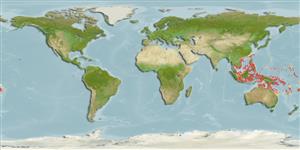Classification / Names
Common names from other countries
Main reference
Size / Weight / Age
Max length : 10.0 cm SL male/unsexed; (Ref. 48637)
Environment
Marine; reef-associated; depth range 1 - 25 m (Ref. 27115), usually 10 - 25 m (Ref. 48637)
Climate / Range
Tropical; 22°C - 28°C (Ref. 27115), preferred ?; 25°N - 24°S
Distribution
Short description
Dorsal
spines
(total): 7;
Dorsal
soft rays
(total): 10;
Anal
spines: 1;
Anal
soft rays: 9. Predorsal scales absent. Occurs in two color phases, one yellow and the other with whitish ground color; both forms with 4-5 dusky bars (although faint in yellow fish) and fine pale blue or white spotting on head and anterodorsal part of body and fins. A dark brown streak above maxilla (Ref. 27362); further characterized by: brown snout; presence of thin brown line along edge of upper jaw; united pelvic fins, presence of frenum; longitudinal scale series 92-95; head without scales; greatest depth of body 4.4-4.6 in SL; rounded caudal fin, about equal to head length (Ref. 90102).
IUCN Red List Status (Ref. 115185)
Threat to humans
Harmless
Human uses
Aquarium: commercial
More information
Common namesSynonymsMetabolismPredatorsEcotoxicologyReproductionMaturitySpawningFecundityEggsEgg development
ReferencesAquacultureAquaculture profileStrainsGeneticsAllele frequenciesHeritabilityDiseasesProcessingMass conversion
Tools
Special reports
Download XML
Internet sources
Estimates of some properties based on models
Phylogenetic diversity index
PD50 = 0.5000 many relatives (e.g. carps) 0.5 - 2.0 few relatives (e.g. lungfishes)
Trophic Level
3.4 ±0.3 se; Based on size and trophs of closest relatives
Resilience
High, minimum population doubling time less than 15 months (Preliminary K or Fecundity.)
Vulnerability
Low to moderate vulnerability (26 of 100)
Price category
